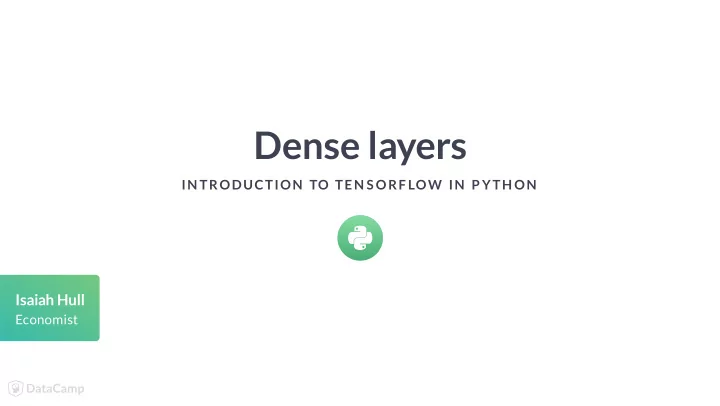

Dense layers IN TRODUCTION TO TEN S ORF LOW IN P YTH ON Isaiah Hull Economist
The linear regression model INTRODUCTION TO TENSORFLOW IN PYTHON
What is a neural network? INTRODUCTION TO TENSORFLOW IN PYTHON
What is a neural network? A dense layer applies weights to all nodes from the previous layer. INTRODUCTION TO TENSORFLOW IN PYTHON
A simple dense layer import tensorflow as tf # Define inputs (features) inputs = tf.constant([[1, 35]]) # Define weights weights = tf.Variable([[-0.05], [-0.01]]) # Define the bias bias = tf.Variable([0.5]) INTRODUCTION TO TENSORFLOW IN PYTHON
A simple dense layer # Multiply inputs (features) by the weights product = tf.matmul(inputs, weights) # Define dense layer dense = tf.keras.activations.sigmoid(product+bias) INTRODUCTION TO TENSORFLOW IN PYTHON
De�ning a complete model import tensorflow as tf # Define input (features) layer inputs = tf.constant(data, tf.float32) # Define first dense layer dense1 = tf.keras.layers.Dense(10, activation='sigmoid')(inputs) INTRODUCTION TO TENSORFLOW IN PYTHON
De�ning a complete model # Define second dense layer dense2 = tf.keras.layers.Dense(5, activation='sigmoid')(dense1) # Define output (predictions) layer outputs = tf.keras.layers.Dense(1, activation='sigmoid')(dense2) INTRODUCTION TO TENSORFLOW IN PYTHON
High-level versus low-level approach High-level approach Low-level approach High-level API operations Linear-algebraic operations dense = keras.layers.Dense(10,\ prod = matmul(inputs, weights) activation='sigmoid') dense = keras.activations.sigmoid(prod) INTRODUCTION TO TENSORFLOW IN PYTHON
Let's practice! IN TRODUCTION TO TEN S ORF LOW IN P YTH ON
Activation functions IN TRODUCTION TO TEN S ORF LOW IN P YTH ON Isaiah Hull Economist
What is an activation function? Components of a typical hidden layer Linear : Matrix multiplication Nonlinear : Activation function INTRODUCTION TO TENSORFLOW IN PYTHON
Why nonlinearities are important INTRODUCTION TO TENSORFLOW IN PYTHON
Why nonlinearities are important INTRODUCTION TO TENSORFLOW IN PYTHON
A simple example import numpy as np import tensorflow as tf # Define example borrower features young, old = 0.3, 0.6 low_bill, high_bill = 0.1, 0.5 # Apply matrix multiplication step for all feature combinations young_high = 1.0*young + 2.0*high_bill young_low = 1.0*young + 2.0*low_bill old_high = 1.0*old + 2.0*high_bill old_low = 1.0*old + 2.0*low_bill INTRODUCTION TO TENSORFLOW IN PYTHON
A simple example # Difference in default predictions for young print(young_high - young_low) # Difference in default predictions for old print(old_high - old_low) 0.8 0.8 INTRODUCTION TO TENSORFLOW IN PYTHON
A simple example # Difference in default predictions for young print(tf.keras.activations.sigmoid(young_high).numpy() - tf.keras.activations.sigmoid(young_low).numpy()) # Difference in default predictions for old print(tf.keras.activations.sigmoid(old_high).numpy() - tf.keras.activations.sigmoid(old_low).numpy()) 0.16337568 0.14204389 INTRODUCTION TO TENSORFLOW IN PYTHON
The sigmoid activation function Sigmoid activation function Binary classi�cation Low-level: tf.keras.activations.sigmoid() High-level: sigmoid INTRODUCTION TO TENSORFLOW IN PYTHON
The relu activation function ReLu activation function Hidden layers Low-level: tf.keras.activations.relu() High-level: relu INTRODUCTION TO TENSORFLOW IN PYTHON
The softmax activation function Softmax activation function Output layer (>2 classes) High-level: tf.keras.activations.softmax() Low-level: softmax INTRODUCTION TO TENSORFLOW IN PYTHON
Activation functions in neural networks import tensorflow as tf # Define input layer inputs = tf.constant(borrower_features, tf.float32) # Define dense layer 1 dense1 = tf.keras.layers.Dense(16, activation='relu')(inputs) # Define dense layer 2 dense2 = tf.keras.layers.Dense(8, activation='sigmoid')(dense1) # Define output layer outputs = tf.keras.layers.Dense(4, activation='softmax')(dense2) INTRODUCTION TO TENSORFLOW IN PYTHON
Let's practice! IN TRODUCTION TO TEN S ORF LOW IN P YTH ON
Optimizers IN TRODUCTION TO TEN S ORF LOW IN P YTH ON Isaiah Hull Economist
How to �nd a minimum 1 Source: U.S. National Park Service INTRODUCTION TO TENSORFLOW IN PYTHON
How to �nd a minimum 1 Source: U.S. National Park Service INTRODUCTION TO TENSORFLOW IN PYTHON
How to �nd a minimum 1 Source: U.S. National Park Service INTRODUCTION TO TENSORFLOW IN PYTHON
INTRODUCTION TO TENSORFLOW IN PYTHON
The gradient descent optimizer Stochastic gradient descent (SGD) optimizer tf.keras.optimizers.SGD() learning_rate Simple and easy to interpret INTRODUCTION TO TENSORFLOW IN PYTHON
The RMS prop optimizer Root mean squared (RMS) propagation optimizer Applies different learning rates to each feature tf.keras.optimizers.RMSprop() learning_rate momentum decay Allows for momentum to both build and decay INTRODUCTION TO TENSORFLOW IN PYTHON
The adam optimizer Adaptive moment (adam) optimizer tf.keras.optimizers.Adam() learning_rate beta1 Performs well with default parameter values INTRODUCTION TO TENSORFLOW IN PYTHON
A complete example import tensorflow as tf # Define the model function def model(bias, weights, features = borrower_features): product = tf.matmul(features, weights) return tf.keras.activations.sigmoid(product+bias) # Compute the predicted values and loss def loss_function(bias, weights, targets = default, features = borrower_features): predictions = model(bias, weights) return tf.keras.losses.binary_crossentropy(targets, predictions) # Minimize the loss function with RMS propagation opt = tf.keras.optimizers.RMSprop(learning_rate=0.01, momentum=0.9) opt.minimize(lambda: loss_function(bias, weights), var_list=[bias, weights]) INTRODUCTION TO TENSORFLOW IN PYTHON
Let's practice! IN TRODUCTION TO TEN S ORF LOW IN P YTH ON
Training a network in TensorFlow IN TRODUCTION TO TEN S ORF LOW IN P YTH ON Isaiah Hull Economist
INTRODUCTION TO TENSORFLOW IN PYTHON
Random initializers Often need to initialize thousands of variables tf.ones() may perform poorly T edious and dif�cult to initialize variables individually Alternatively, draw initial values from distribution Normal Uniform Glorot initializer INTRODUCTION TO TENSORFLOW IN PYTHON
Initializing variables in TensorFlow import tensorflow as tf # Define 500x500 random normal variable weights = tf.Variable(tf.random.normal([500, 500])) # Define 500x500 truncated random normal variable weights = tf.Variable(tf.random.truncated_normal([500, 500])) INTRODUCTION TO TENSORFLOW IN PYTHON
Initializing variables in TensorFlow # Define a dense layer with the default initializer dense = tf.keras.layers.Dense(32, activation='relu') # Define a dense layer with the zeros initializer dense = tf.keras.layers.Dense(32, activation='relu',\ kernel_initializer='zeros') INTRODUCTION TO TENSORFLOW IN PYTHON
Neural networks and over�tting INTRODUCTION TO TENSORFLOW IN PYTHON
Applying dropout INTRODUCTION TO TENSORFLOW IN PYTHON
Implementing dropout in a network import numpy as np import tensorflow as tf # Define input data inputs = np.array(borrower_features, np.float32) # Define dense layer 1 dense1 = tf.keras.layers.Dense(32, activation='relu')(inputs) INTRODUCTION TO TENSORFLOW IN PYTHON
Implementing dropout in a network # Define dense layer 2 dense2 = tf.keras.layers.Dense(16, activation='relu')(dense1) # Apply dropout operation dropout1 = tf.keras.layers.Dropout(0.25)(dense2) # Define output layer outputs = tf.layers.Dense(1, activation='sigmoid')(dropout1) INTRODUCTION TO TENSORFLOW IN PYTHON
Let's practice! IN TRODUCTION TO TEN S ORF LOW IN P YTH ON
Recommend
More recommend